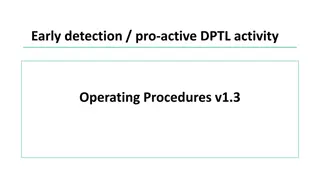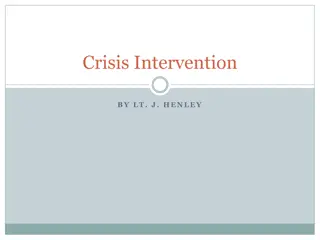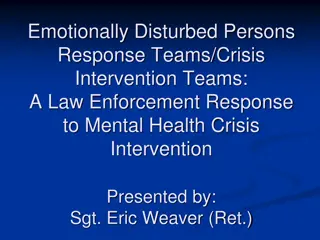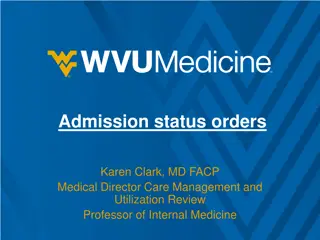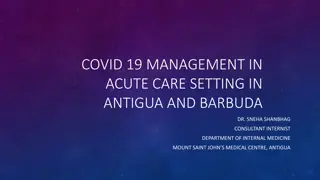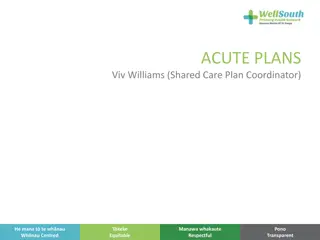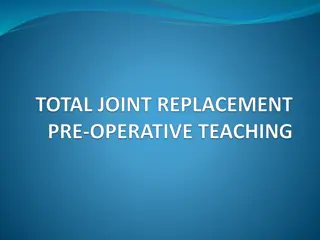Optimising CIT/OPAT in Acute Hospitals for Admission Avoidance and Early Discharge
Ms. Lorraine Myler, an OPAT/CIT Liaison Nurse at Beaumont Hospital, presents an overview of OPAT (Outpatient Parenteral Antimicrobial Therapy) and CIT (Community Intervention Team). The presentation covers the benefits of OPAT/CIT services, referral processes, facts and figures from Beaumont Hospital, reasons for the success of OPAT/CIT, types of OPAT (H-OPAT, C-OPAT, S-OPAT), roles of CIT, and referrals to CIT in Beaumont. The content emphasizes the importance of these services in providing essential healthcare support to patients while reducing hospital admissions and promoting early discharge.
Download Presentation

Please find below an Image/Link to download the presentation.
The content on the website is provided AS IS for your information and personal use only. It may not be sold, licensed, or shared on other websites without obtaining consent from the author.If you encounter any issues during the download, it is possible that the publisher has removed the file from their server.
You are allowed to download the files provided on this website for personal or commercial use, subject to the condition that they are used lawfully. All files are the property of their respective owners.
The content on the website is provided AS IS for your information and personal use only. It may not be sold, licensed, or shared on other websites without obtaining consent from the author.
E N D
Presentation Transcript
OPTIMISING CIT / OPAT IN ACUTE HOSPITALS FOR ADMISSION AVOIDANCE AND EARLY DISCHARGE Ms Lorraine Myler OPAT/CIT Liaison Nurse, Beaumont Hospital
PRESENTATION OVERVIEW What is OPAT and CIT? Benefits of service OPAT/CIT service in Beaumont Referral process Beaumont Facts and figures Why is OPAT/CIT successful? Evaluation of service
WHAT IS OPAT? Outpatient=Delivered in patient s home/ infusion clinic Parenteral = intravenous (IV) Antimicrobial = antibacterial, antifungal, antiviral Therapy = treating infection Available to public patients via: HSE OPAT Clinical Programme and local CIT & some private health insurers offer OPAT service to subscribers
TYPES OF OPAT H-OPAT= Home OPAT Nurse visits the patient s home to administer IV antimicrobials C-OPAT= Community OPAT Nurse visits the patient s nursing home to administer IV via PVC (short course) or midline/PICC (>10 days OPAT) H-OPAT & C-OPAT Up to three times per day schedule possible, but places logistical burden on nurse time once/twice daily dosing schedules easier to manage S-OPAT= Self OPAT Patient or patient s carer is trained to administer their own IV via a midline or PICC More flexible dosing schedule possible and can use infusion pumps that administer drug over 23 hours
WHAT IS CIT? Community Intervention Team: Dublin North and South set up in 2006 as pilot. Since then service available in more locations Roles of CIT: Provide H-OPAT or C-OPAT up to three times per day Provide short-term nursing support to assist with the management of acute illnesses such as; minor muscloskeletal injury, exacerbation of chronic illness and infection Home phlebotomy service to include INR monitoring 4. In some locations, CIT also provide catheter care and wound dressing for a period of time 1. 2. 3.
BEAUMONTS REFERRALS TO CIT In 2017, 1,347 referrals to Dublin North CIT Reasons for referrals: H-OPAT & C-OPAT INR monitoring Carer support Home phlebotomy Palliative care support Medication education and compliance. Central venous catheter care. Administration of Infliximab infusions. Acute nursing assesment (e.g., vital signs)
BENEFITS OF OPAT & CIT Patient satisfaction Frees up acute hospital beds for use by other patients Saves hospital costs Reduces length-of-stay & potential for admission avoidance in carefully-selected patient groups Reduces potential exposure to healthcare pathogens e.g., C. difficile, antimicrobial resistant organisms (e.g., CPE, MRSA)
BEAUMONTS OPAT/CIT SERVICE OPAT available to Beaumont Hospital patients since 2010: March 2014: OPAT/CIT Liaison Nurse 1.0 WTE post created to promote and coordinate the OPAT/CIT referral process, regardless of the external provider: ALL patients discharged on OPAT are captured October 2016: Second 1.0 WTE post created based on workload and need for service continuity Clinical oversight and governance provided by Consultants in Clinical Microbiology and Infectious Diseases ALL OPAT referrals are discussed and approved
REFERRAL PROCESS IN BEAUMONT Proactive daily case finding by OPAT/ CIT Liaison Nurses (Monday Friday): Attending post-call medical model meeting Receiving post-call surgical sign out via e-mail Attend bed flow meetings with all ward CNMs Liaise with ambulatory nurse in ED and FITT team Referrals received by OPAT/CIT nurses from clinical teams Suitable patients already under supervision of Clinical Microbiology and ID teams referred to OPAT service
OPAT/CIT REFERRAL PROCESS IN BEAUMONT Every referral triaged and reviewed by OPAT/CIT Liaison Nurses as soon as possible OPAT referrals discussed with Consultant Clinical Microbiologist daily at 11am, with ID patients managed by ID service Treatment plan recommended and communicated to team EXPERT TRIAGE IS CRITICAL TO AVOID UNNECESSARY OPAT If patient meets criteria, OPAT/CIT arranged as soon as possible WEEKLY OPD REVIEW IN ADMITTING CONSULTANT OPD MANDATORY FOR OPAT DISCHARGES
WE DECLINED OPAT FOR 53% OF OUR REFERRALS IN 2017 1%1%1% 4%2% 5% Suitable oral switch Not ready for discharge 42% IV stopped prior to discharge 20% Unsuitable social cirumstance OPAT capacity full Patient declined OPAT 24% Patient not on IV Other option for IV admin Unsuitable infection type
BEAUMONT HOSPITAL ANNUAL OPAT REFERRALS & DISCHARGES 545 600 532 476 475 500 400 301 OPAT Referrals OPAT Discharges 258 300 223 186 200 100 0 2014 2015 2016 2017
REFERRALS TO HSE NATIONAL OPAT SERVICE: JANUARY JUNE 2018 Source: HSE National OPAT programme
REFERRALSTO HSE NATIONAL OPAT SERVICE: JANUARY JUNE 2018 We are even busier, as above data does not include our referrals to private health insurers Source: HSE National OPAT programme
BEAUMONTHOSPITALANNUALDISCHARGESBY OPATPROVIDER 183 181 200 171 H/C-OPAT 134 150 S-OPAT 100 73 55 47 45 41 Private Health Insurers 50 20 11 7 0 2014 2015 2016 2017
TOP 5 INFECTIONTYPESWEUSED OPATFORIN 2017 Osteomyelitis (Bone infection) Surgical site infection 46 32 Cellulitis Urosepsis Infective exacerbation of bronchiectesis 24 19 13
WHYIS OPAT & CIT SUCCESSFULIN BEAUMONT? Open communication with all stakeholders (inside and outside hospital) Visibility OPAT/CIT Nurses visit wards and attend key meetings daily & always approachable Service promotion Screensavers, posters to advertise the service, NCHD induction and Grand Rounds presentations, ward-based education Information folders available on all wards and also on Q pulse Quarterly activity reports on OPAT service Easy referral process No restrictions on who refers patients and phone call sufficient to refer a patient
WHYIS OPAT & CIT SUCCESSFULIN BEAUMONT? Response time Fast response to all referrals, usually same day Strong relationships & governance Strong communication system with Clinical Microbiology & ID teams ensures patients are discussed in a timely fashion. Daily 11am meeting with Microbiologist. We closely monitor outcomes DocumentationAll OPAT or CIT referrals recorded and discharges overseen by OPAT/CIT liaison nurses ensuring all documentation is completed which reduces chances of mistakes causing delays to discharge Facilitator OPAT/CIT nurses follow OPAT patients from the initial referral until therapy is complete, thus giving all stakeholders a designated person to communicate with
WHYIS OPAT & CIT SUCCESSFULIN BEAUMONT? Buy in from consultants and ward CNMs leads to prompt referral to the service which in turn facilitates early discharge. Fast track Access for patients needing midline/PICC fastracked with radiology where possible prevents delayed discharge Prevent delays If delays occur in compounding of medications/line placement for S-OPAT patients, we aim to facilitate the patient on the H-OPAT service until S-OPAT commences or device is inserted ensuring no delay on discharge
CASE STUDYADMISSIONAVOIDANCE ED RANP reviews patient with cellulitis of leg - GP referral as not responding to oral antimicrobials. Otherwise well Referred to OPAT/CIT liaison nurse. Pt reviewed and discussed with Microbiologist Discharged from ED to home under the care of ED consultant: OPAT x 72 hours and ED review and then switched to PO antimicrobials to complete treatment course
CASESTUDY EARLYDISCHARGE Diabetic foot osteomyelitis patient admitted under endocrine team Day 2: Referral to OPAT/CIT liaison nurses. Reviewed and discussed with Microbiologist. Reviewed by Microbiologist on the ward and OPAT plan documented Patient did S-OPAT on a previous infection episode and wanted to do it again. Unfortunately, radiology could not insert a midline until the following week Patient discharged on H-OPAT x 1 week. Midline inserted and then switched to S-OPAT service to complete remaining 3 weeks OPAT
EVALUATIONOFOUR SERVICE GOVERNANCE AND OUTCOMES ARE IMPORTANT TO US We produce and disseminate quarterly & annual activity reports We monitor outcomes: 30 day readmission rates, complications of treatment, C. difficile infection, vascular catheter related bloodstream infections, complaints received
EVALUATIONOFOUR SERVICE PATIENTS LIKE OPAT! Recent OPAT patient satisfaction survey Overall very positive feedback: Good nurses, informed, always contactable by phone for advice and queries Excellent service, well delivered in all aspects, much appreciated I thought the service was very good, girls nice and helpful. I would recommend your service to everyone. Very professional
ACKNOWLEDGEMENTS Ms Anne Platts: OPAT/CIT Liaison Nurse Dr Karen Burns: Consultant Clinical Microbiologist Clinical Microbiology & Infectious Diseases Teams OPAT Management Control Centre CIT Dublin North All MDT staff of Beaumont Hospital
THANKYOUFORYOURATTENTION lorrainemyler@beaumont.ie




